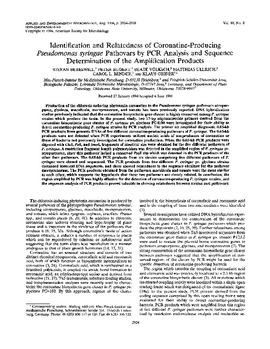| dc.contributor.author | Bereswill, Stefan | |
| dc.contributor.author | Bugert, Peter | |
| dc.contributor.author | Volksch, Beate | |
| dc.contributor.author | Ullrich, Matthias | |
| dc.contributor.author | Bender, Carol L. | |
| dc.contributor.author | Geider, Klaus | |
| dc.date.accessioned | 2015-10-16T20:47:40Z | |
| dc.date.available | 2015-10-16T20:47:40Z | |
| dc.date.issued | 1994-08 | |
| dc.identifier | okds_Bender_AEM_1994-08.pdf | |
| dc.identifier.citation | Bereswill, S., Bugert, P., Volksch, B., Ullrich, M., Bender, C. L., & Geider, K. (1994). Identification and relatedness of coronatine-producing Pseudomonas syringae pathovars by PCR analysis and sequence determination of the amplification products. Applied and Environmental Microbiology, 60(8), 2924-2930. https://doi.org/10.1128/aem.60.8.2924-2930.1994 | |
| dc.identifier.uri | https://hdl.handle.net/11244/19761 | |
| dc.description.abstract | Production of the chlorosis-inducing phytotoxin coronatine in the Pseudomonas syringae pathovars atropurpurea, glycinea, maculicola, morsprunorum, and tomato has been previously reported. DNA hybridization studies previously indicated that the coronatine biosynthetic gene cluster is highly conserved among P. syringae strains which produce the toxin. In the present study, two 17-bp oligonucleotide primers derived from the coronatine biosynthetic gene cluster of P. syringae pv. glycinea PG4180 were investigated for their ability to detect coronatine-producing P. syringae strains by PCR analysis. The primer set amplified diagnostic 0.65-kb PCR products from genomic DNAs of five different coronatine-producing pathovars of P. syringae. The 0.65-kb products were not detected when PCR experiments utilized nucleic acids of nonproducers of coronatine or those of bacteria not previously investigated for coronatine production. When the 0.65-kb PCR products were digested with ClaI, PstI, and SmaI, fragments of identical size were obtained for the five different pathovars of P. syringae. A restriction fragment length polymorphism was detected in the amplified region of P. syringae pv. atropurpurea, since this pathovar lacked a conserved PvuI site which was detected in the PCR products of the other four pathovars. The 0.65-kb PCR products from six strains comprising five different pathovars of P. syringae were cloned and sequenced. The PCR products from two different P. syringae pv. glycinea strains contained identical DNA sequences, and these showed relatedness to the sequence obtained for the pathovar morsprunorum. The PCR products obtained from the pathovars maculicola and tomato were the most similar to each other, which supports the hypothesis that these two pathovars are closely related. In conclusion, the region amplified by PCR was highly effective for the detection of coronatine-producing P. syringae strains, and the sequence analysis of PCR products proved valuable in showing relatedness between strains and pathovars. | |
| dc.format | application/pdf | |
| dc.language | en_US | |
| dc.publisher | American Society for Microbiology | |
| dc.rights | This material has been previously published. In the Oklahoma State University Library's institutional repository this version is made available through the open access principles and the terms of agreement/consent between the author(s) and the publisher. The permission policy on the use, reproduction or distribution of the material falls under fair use for educational, scholarship, and research purposes. Contact Digital Resources and Discovery Services at lib-dls@okstate.edu or 405-744-9161 for further information. | |
| dc.title | Identification and relatedness of coronatine-producing Pseudomonas syringae pathovars by PCR analysis and sequence determination of the amplification products | |
| osu.filename | okds_Bender_AEM_1994-08.pdf | |
| dc.description.peerreview | Peer reviewed | |
| dc.identifier.doi | 10.1128/aem.60.8.2924-2930.1994 | |
| dc.description.department | Plant Pathology | |
| dc.type.genre | Article | |
| dc.type.material | Text | |
